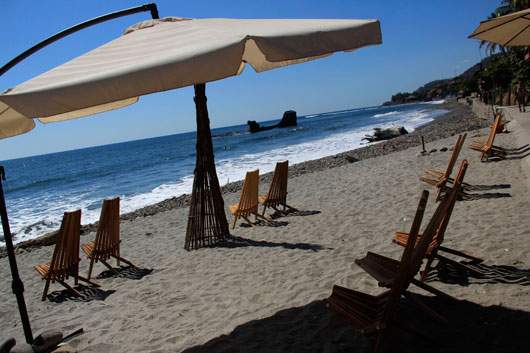San Salvador wasn’t as bad as I’d been led to expect. Sure, the air was like pancake batter, so packed with black gaseous vomit from the ceaseless succession of buses and cars that I’d catch myself breathing shallowly in self-preservation, but the people on the street were friendly, often beating me to the punch with their “Buenos dias” or “Como esta?”
Within a day or two I had a pseudo-family in the pupuseria around the corner, whose ample proprietress delighted in my blushes when she’d propose I marry her daughter and learn the pupusa business. With the fresh fruit licuado stand a few steps away combining carrots, ginger, and guayaba, I considered her offer more than she realized.
But I am not well-suited to endless days of pavement and press, life under the tangled electrical wires that always remind me of those spiders given hallucinogens. So when the day’s pre-election actions were irrelevant to me, it was the perfect time for a day trip to El Salvador’s famous beaches.
“Playa Tunco, you gotta go to Playa Tunco!” Said one of the delegates. “I heard about it from some Canadian girls on the bus last month. They went there, then down into Nicaragua and Costa Rica, but came back because they said it was the best place they’d been in Central America. Do you surf?”
I suspected that calculating look in his eye was weighing the costs and benefits of skipping out on delegate training too. It’s never too late to learn to surf.
Less than an hour from San Salvador’s alien circulatory system of five-lane thoroughfares and dead-end byways, Playa Tunco is one in a line of fishing villages growing into tourist towns along the Pacific Coast west of La Libertad.

The beach was rocks in some areas, and dark sand in others that seared my soles when it flupped into my flip flops. The sun was straight overhead and the tide was in, so everyone was taking shelter except for a couple ambulating jewelry vendors, a roving mariachi band, two die-hard surfers, one Italian girl laying out, and a dork with a camera wanting to tell you about all of it.
That sun is a castigating presence though, and I joined the people in the shade, where a table of Brazilians was plowing through thick hamburgers. They hadn’t realized they were in Tunco, having wandered down from Playa El Sunzal just to the west.

“We like it here, you can surf any time. Not so many people, but there is a lot of party at night,” summarized one guy, reaching for the ketchup. “Do you know when the tide changes?” That is usually the most pressing question in Tunco, but I was curious if the election had affected their decision to come to El Salvador.
“Oh, right, there’s an election. When is that, anyway?”
Tunco is pretty much one lateral road, where you can roll out of bed, take your clothes to the laundry, and sip smoothies while you wait for the waves.
That’s what Marcus and Marieke from Rotterdam were doing, working their way through blends of mango, banana, and almond while they discussed which break to visit today. Abby and Niles from Ontario planned to take the day off, and ordered a second round of mango, papaya, orange, milk, and honey. While I waited for my own mix of coconut, papaya, spinach, and sunflower seeds, I asked if they’d been afraid to come to El Salvador.
They all knew what I meant, but gave immediate answers. “No way, those fears are always overstated. Sure, there are bad areas, and sure you have to pay attention, but this place isn’t that different from most of the others I’ve been,” offered Marcus.
Abby added “I lived in Guatemala for a year and loved it, and they have a really bad reputation too. I’ve never had a problem in either place. I just don’t wear jewelry, carry much cash, or wander places without asking about them first.”
The tourist enclaves are sufficiently isolated from the nation’s issues that the election’s main repercussion was the “Ley Seca” which prohibits the sale of alcohol in the days prior to voting. Just as in the Bay Islands of Honduras, the trouble seems to stay out. We can only hope that the functionality of these zones can somehow seep some benefit into the nation at large, even if they sometimes feel like colonization.
Yet as I asked around, it seemed like a lot of the tourism businesses were locally owned, more so than in some other Central American countries at least. Perhaps the violence of the past few decades has kept foreign investors away to some extent, giving El Salvador a chance at self-ownership of their tourism industry. With this week’s fair and peaceful elections, the future of the country looks more stable, so that chance may be running out.
But my pupuseria friends were Salvadoreños, as was the man selling swimsuits in Tunco, and I was curious to see if I would find the same local ownership in another of the country’s main tourist destinations. I made plans to head for the hills…
Read Ethical Traveler's Reprint Policy.
